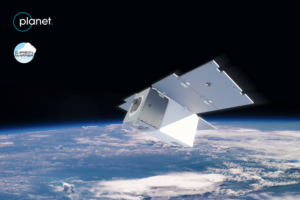The constellation is one element of Carbon Mapper, a public-private partnership aimed at providing information to help limit greenhouse gas emissions.
California government agencies including the state’s Air Resources Board have been laying the groundwork for Carbon Mapper since 2016 when then-Gov. Jerry Brown reacted to Trump Administration threat to NASA climate research by saying, “California will launch its own damn satellites.”
Partners, including the University of Arizona, Arizona State University, the High Tide Foundation and the non-profit RMI, are supporting the campaign to pair hyperspectral sensors developed at JPL with satellites roughly the size of Planet SkySats.
“These home-grown satellites are a game-changer,” California Gov. Gavin Newsom said in a statement. “They provide California with a powerful, state-of-the-art tool to help us slash emissions of the super-pollutant methane – within our own borders and around the world. That’s exactly the kind of dynamic, forward-thinking solution we need now to address the existential crisis of climate change.”
The first two Carbon Mapper satellites scheduled to launch in 2023 are designed to detect 80 percent of the largest global methane sources as well as the major carbon dioxide emitters. A larger constellation to follow in 2025 will begin providing frequent observations of greenhouse gas sources, said Shanti Rao, JPL Carbon Mapper constellation architect.
“Carbon Mapper uses NASA’s best available remote sensing technology,” Rao said. “The sensor’s very high signal-to-noise ratio and unmatched spatial and spectral uniformity are essential to seeing methane plumes against the background of Earth under a variety of lighting conditions.”
Carbon Mapper also is designed to heighten public awareness and understanding of greenhouse gas emissions. Data captured by the satellites plus airborne sensors surveying major oil and gas fields will be shared through a public portal being developed by the California Air Resources Board.
The ultimate size of the Carbon Mapper constellation has not yet been determined.
Carbon Mapper is the latest addition to a virtual constellation of satellites seeking to pinpoint, measure and monitor greenhouse gas emissions. That constellation includes Europe’s Copernicus Sentinel-5 satellite, NASA’s Orbiting Carbon Observatory and GHGSat of Canada’s constellation of methane-monitoring spacecraft.
Carbon Mapper’s visible and infrared imaging spectrometers are designed to provide data with a resolution of 30 meters per pixel, according to a paper presented in December at the virtual American Geophysical Union conference.
Similar instruments, also developed at JPL, have spotted methane from airplanes and are expected to survey Earth’s moon and Jupiter’s moon Europa on upcoming NASA missions.
“This decade represents an all-hands-on-deck moment for humanity to make critical progress in addressing climate change,” Riley Duren, Carbon Mapper CEO and a University of Arizona research scientist, said in a statement. “Our mission is to help fill gaps in the emerging global ecosystem of methane and CO2 monitoring systems by delivering data that are timely, actionable and accessible for science-based decision making.”
The California-based High Tide Foundation led the campaign to find philanthropic backing for the work. Contributors include the Grantham Foundation for Protection of the Environment, Bloomberg Philanthropies, Zegar Family Foundation and the University of Arizona.
“JPL is excited to be pioneering this research effort, which will provide critical information about greenhouse gases and the future of Earth’s climate,” James Graf, director for JPL’s Earth Science and Technology Directorate, said in a statement. “This effort is the first time we have partnered on a space mission with a consortium of nonprofit organizations, universities and the State of California.”



